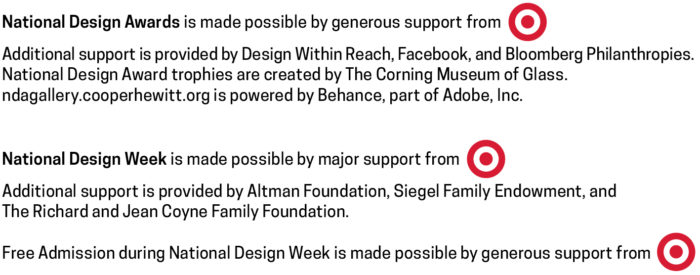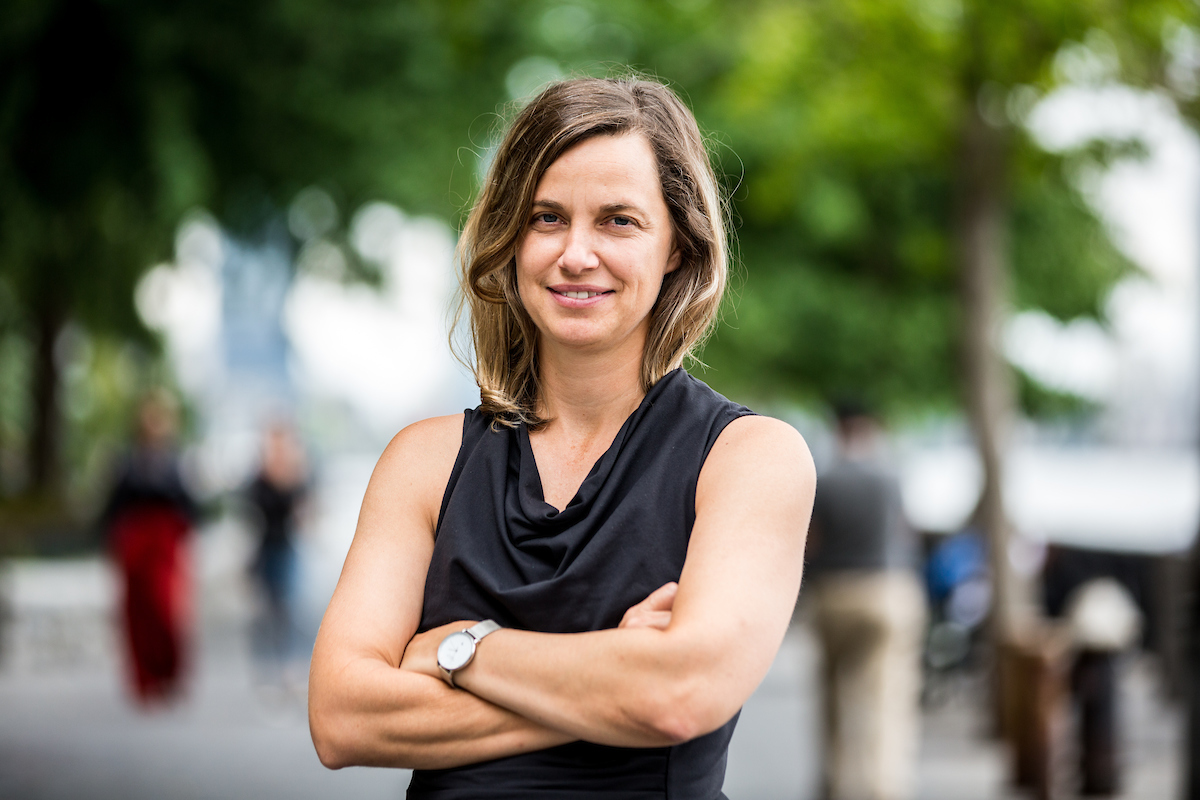SCAPE Landscape Architecture is the recipient of the 2019 National Design Award for Landscape Architecture. Founded by MacArthur Fellow Kate Orff in 2005, SCAPE believes landscape architecture can enable positive change in communities through the creation of regenerative living infrastructure and public landscapes. The studio works to integrate natural cycles and systems into environments across all scales, from small urban parks, such as the First Avenue Water Plaza in New York, to large-scale resilient coastal infrastructure, such as Living Breakwaters on Staten Island, which aims to buffer wave damage and provide a more biodiverse habitat. SCAPE’s diverse outputs include built landscapes, planning frameworks, research, books and installations, with the goal of connecting people to their immediate environment and creating dynamic and adaptive landscapes for the future.
What three adjectives define “good design” to you?
Immersive, engaged, biodiverse.
Who is a designer, historic or working today, that you would invite to a dinner party?
I’ve always revered Rachel Carson. She wrote in incredibly visual poetic terms about the inter-relationship of living things to each other and their environment. Her book “The Sea Around Us” is so rich with textures and scale—it’s a love letter to a world out of view, literally underwater. You can’t always love what you can’t see. Growing up near the Chesapeake Bay in Maryland, I also loved marshiness, bays, and shoals. But only through her writing did I begin to imagine pulsing jellyfish, phosphorescent shrimp, saturated mossy ledges, crabs hiding in their tide pool homes, rocks paved with misty blue mussels—and imagine them all as design “clients.” Like the best designers, she knew how to look and see holistically. Carson even noticed rising ocean temperatures and species climate migration back in the 1950s.
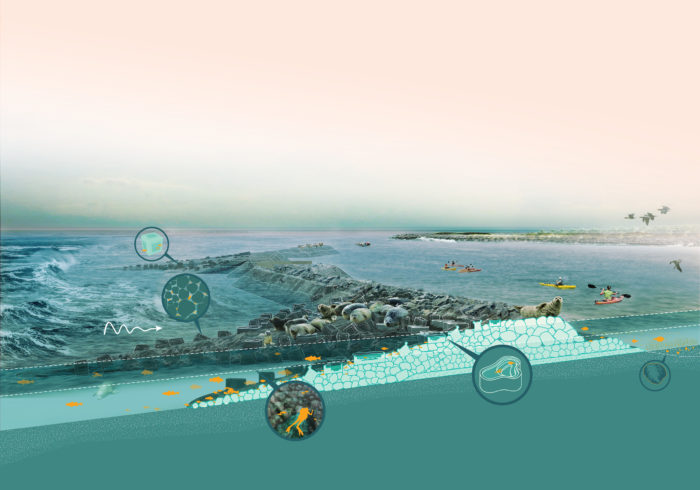
Designed for the shoreline of southern Staten Island, the Living Breakwaters are living in-water infrastructure that reduce erosion, attenuate damaging storm waves and enhance ecosystems (Tottenville, New York, 2015–ongoing). Project partners: Parsons Brinckerhoff, ARCADIS, Ocean and Coastal Consultants, SeArc Ecological Marine Consulting, the New York Harbor Foundation, LOT-EK, Architecture, MFS Consulting Engineers, Prudent Engineering. Photo: SCAPE and the NYS Governor’s Office of Storm Recovery
How do you relax on your day off?
I am married and have two children, ages 12 and 8. We like going to the beach and playing tennis. I do try to compartmentalize and keep my family life separate from the throes of teaching at Columbia and working on projects in the SCAPE office.
What inspires you when you’re feeling stuck?
I usually try to just power through “writer’s block” or the design equivalent of that. There is no better way than just making that next thing—switching from drawing to model, or from plan to section. I’m not a perfectionist. I don’t think you can be a landscape architect and love the agency of other living things while being a perfectionist, so also just letting the world into your process more is a quick way to realize the complexity is inherent and get unstuck
What do Cooper Hewitt and the National Design Awards mean to you?
I’m so excited for SCAPE to receive this honor! We are a national practice with a dedicated team of talented people and partners who love landscape. We’ve been described before as a “young” practice, but we have so much experience, a portfolio of built work, and have been leading the re-tooling of landscape architecture as a form of activism. It’s encouraging for that to be awarded by the Cooper Hewitt.
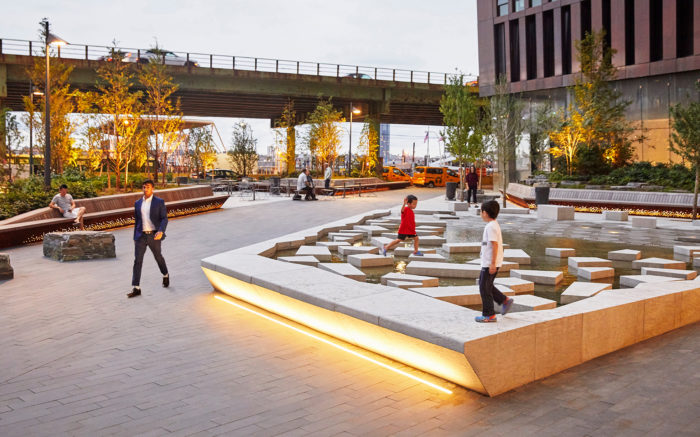
The First Avenue Water Plaza, located along the FDR Drive at the entrance of the American Copper Buildings, serves as an active civic space and a functional storm water management system. The plaza is activated by a layered water collection system that manages multiple types of inundation, including storm water and storm surge, to reduce CSO events and flood impacts (New York, New York, 2018). Project partners: JDS Development Group, SHoP Architects, AKRF, Pine and Swallow Environmental. Photo: Ty Cole Photography
How did you get your start in design?
My late father was an engineer at NASA in the 1970s, and he used to bring home reams and reams of what my sister and I called “computer paper,” which was otherwise meant for the garbage. It had feeder holes on the edges—one side was white and the other had green stripes and computer code. It was a big deal when he would come home on Friday with a fresh batch of paper. I’m sure there’s a better answer, but I really think just having an endless supply of paper and total freedom to make stuff, mess up, and make another thing looking back just got me drawing and making things quickly and not feeling precious or anxious about the process.
How has mentorship influenced your career?
I had a lot of mentors in college at University of Virginia and graduate school at Harvard GSD—men and women—who I can pull advice from in instant recall at any moment! Working with Rem Koolhaas before S,M,L,XL came out also was important for me. He was just so fearless, direct, funny, and brilliant. I was grateful to have him as a thesis advisor; he wasn’t in the mode of architecture as a form of torturous naval-gazing, but rather in the mode of engaging with a global reality.
Looking over your body of work, is there one design project that holds personal significance for you?
Working with photographer Richard Misrach on the book Petrochemical America (Aperture, 2012) was an amazing and eye-opening experience. It was formational for me in terms of thinking about landscape, looking more deeply at the root causes of climate change, listening to the lived experience of people along Cancer Alley, and tying together landscape with environmental justice issues. To this day, I don’t try to recreate an inherited aesthetic—something that makes a glossy magazine photo—but try to reset relationships between things. I learned this from working on “Petrochemical America” with Richard. It was a process of trying to describe through writing and drawing where and how everything had been broken.
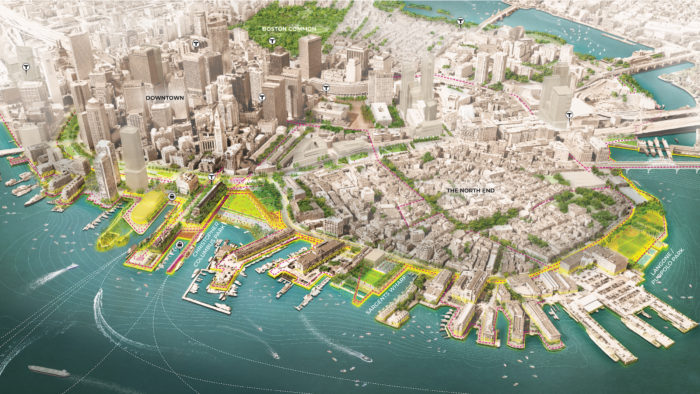
Working with the city of Boston, SCAPE, synthesized a range of ongoing planning efforts with new landscape ideas into an integrated vision, sparking conversations about Boston’s changing waterfront (Boston, Massachusetts, 2017). Project partners: City of Boston, Arcadis, Nitsch Engineering. Photo: SCAPE
How do you think design will change in the next 20 years?
We need to focus on moving away from thinking about design as the consumption of awesome images—something promulgated by Instagram and similar platforms. And we need to get in the mindset and the muck and knit together things and people that have been fragmented. This should reset what we consider to be beautiful in terms of imagery and outcome. The outcome of an incredibly beautiful landscape project might be partly invisible – like the removal of a dam, for example. Un-making damaging practices as a positive and aesthetic act will not be Instagrammable but it will mean life for fish, connection with rivers to their basins, and renewed waterbodies.
What are your words of advice to the next generation of designers?
Being a designer is not some sort of preternatural gift. It comes from the sincere impulse of making change in the world. Passion, grit, intuition, and purpose are key. Keep going!
About the National Design Awards
Cooper Hewitt’s National Design Awards is the only annual program of its kind, bringing national recognition to the ways in which design enriches everyday life. Launched at the White House in 2000 as a project of the White House Millennium Council, the National Design Awards were established to promote design as a vital humanistic tool in shaping the world. Twenty years later, the National Design Awards continue to honor and support excellence, innovation, and lasting achievement in American design. Cooper Hewitt continues to broaden access nationwide to the vision and work of the country’s design leaders through National Design Week and NDA Cities, inspiring people of all ages to engage with design and design thinking.
In celebration of the 20th anniversary of the National Design Awards, Target will offer free admission to all visitors of Cooper Hewitt during National Design Week, Oct. 12–19, to make design accessible to all. Target will also sponsor a series of Cooper Hewitt programming broadening access to the vision and work of the country’s design leaders and inspiring people of all ages to engage with design and design thinking.
